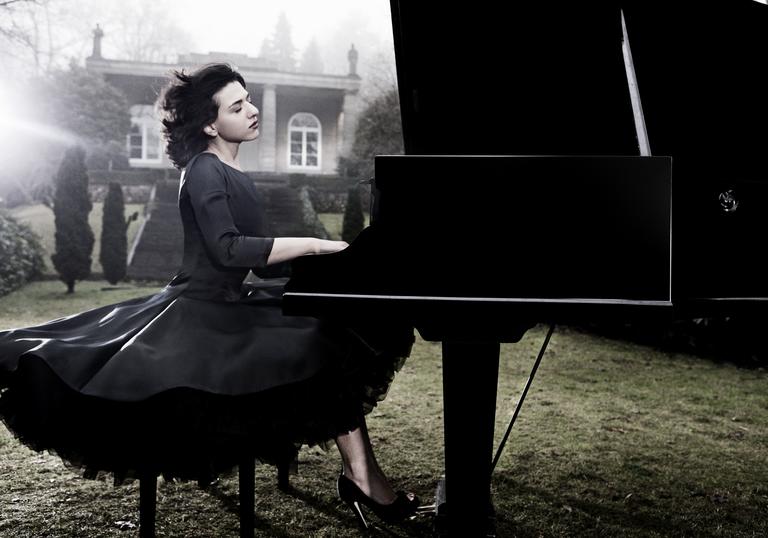You don’t get any more famous than Satie’s First Gymnopédie or Bach’s Air from his Third Orchestral Suite, better known as the Air on the G string, both of which she plays tonight, effortlessly taking ownership of Bach’s textures through rolled chords and washes of sound via the sustaining pedal. In the case of the Satie, its very spareness demands musicianship of great subtlety. Satie’s quiet revolution is all the more striking when you put it into context – at the time he was finishing his three Gymnopédies in 1888, Maher was battling with his First Symphony and Tchaikovsky writing his great ballet The Sleeping Beauty. Maurice Ravel hit the nail on the head when he described Satie as the precursor of modern music.
And how potently Chopin follows Satie in this recital, the Fourth of his 24 Preludes having a solemnity and quiet grandeur that defy its brevity, its theme almost devoid of colour and warmth as if expressing some heartfelt grief (tellingly, it was one of the pieces performed at the composer’s own funeral). That restraint can also be found in the A minor Mazurka, Op 17 No 4, in which Chopin flicks off the earthiness of this peasant dance and transforms it into something altogether more fragile, the flights of fantasy in the right hand secured only by the constancy of the rhythm in the left hand. At the opposite end of the emotional spectrum are Chopin’s Third Scherzo and Polonaise, Op 53. The legendary pianist Alfred Cortot summed up Chopin’s four scherzos as ‘games, as it were, of terror, dances feverish and hallucinatory’ – an apt description of the Third, which opens with a crunching dissonance and a no-nonsense muscularity to its main theme, counterbalanced by more consoling ideas which proceed to battle for dominance until the very end. If the mazurka was the dance of the people, the polonaise represented Polish nobility, and you can hear that from the off in the A-flat major Polonaise, which struts into life with considerable aplomb. It is perhaps the most extrovert piece Chopin ever wrote, as he unveils dazzling theme after theme, each highly original in colour and harmony. Its nickname of ‘Heroic’ surely comes from the inner section, with its vehement pounding octave figure in the bass.
François Couperin was, like J S Bach, part of a remarkable musical dynasty and his keyboard works exploit the colouristic possibilities of the harpsichord to the full. 'Les Baricades mistérieuses' (which literally translates as ‘The mysterious barricades’) has been the subject of much speculation, some of it – that it refers to a woman's eyelashes or even a chastity belt – admittedly fanciful. Whatever its meaning, there’s no doubt of the potency of this hypnotic piece, with Couperin’s melodies growing out of its harmonies and vice versa to create something infuriatingly memorable.
Khatia Buniatishvili gives us a lyrical interlude before Chopin’s Polonaise, with two pieces by Schubert. His eight Impromptus were compiled posthumously by his publisher, and the term itself implies something spontaneous, seemingly plucked from the air.
The third of D899 is nocturne-like in character, its rippling right-hand underpinning a solemn song-like melody, the mood turning darker for the minor-key inner section. From song-like to the genuine article, in the form of Schubert’s ‘Ständchen’ (Serenade), from his last song-cycle Schwanengesang, which, like the impromptus, was posthumously put together. Franz Liszt was a huge admirer of Schubert and did much to keep the flame alive in the decades following the latter’s premature death. Nowhere is his mastery of transcription more elegantly revealed than in this Lied, in which the piano becomes both voice and accompaniment with breath-taking ease and beauty.
Khatia Buniatishvili ends her recital with more Liszt. The triumph of his reworking of Bach’s Prelude and Fugue for organ, BWV543, is the way in which he makes the result sound so natural that you forget it’s a transcription. The majestic Prelude, whose grandeur is offset by outbursts of toccata-like writing, is followed by a Fugue that begins almost winsomely, gradually building in complexity to a grandiose, almost orchestral-sounding close. After such affirmation Liszt’s dreamy Consolation No 3 recalls the inwardness of the Chopin Prelude we heard earlier. And finally, Liszt’s headily brilliant Second Hungarian Rhapsody, rendered even more dazzling through this reworking by the great Russian-American pianist Vladimir Horowitz. If Liszt’s relationship to his birthplace was more romantic than anything else (he’d left at the age of nine and Hungarian was his third language, after German and French), in spirit he was Hungarian; and who are we to argue over geographic niceties when the result is so infectious?
© Harriet Smith

